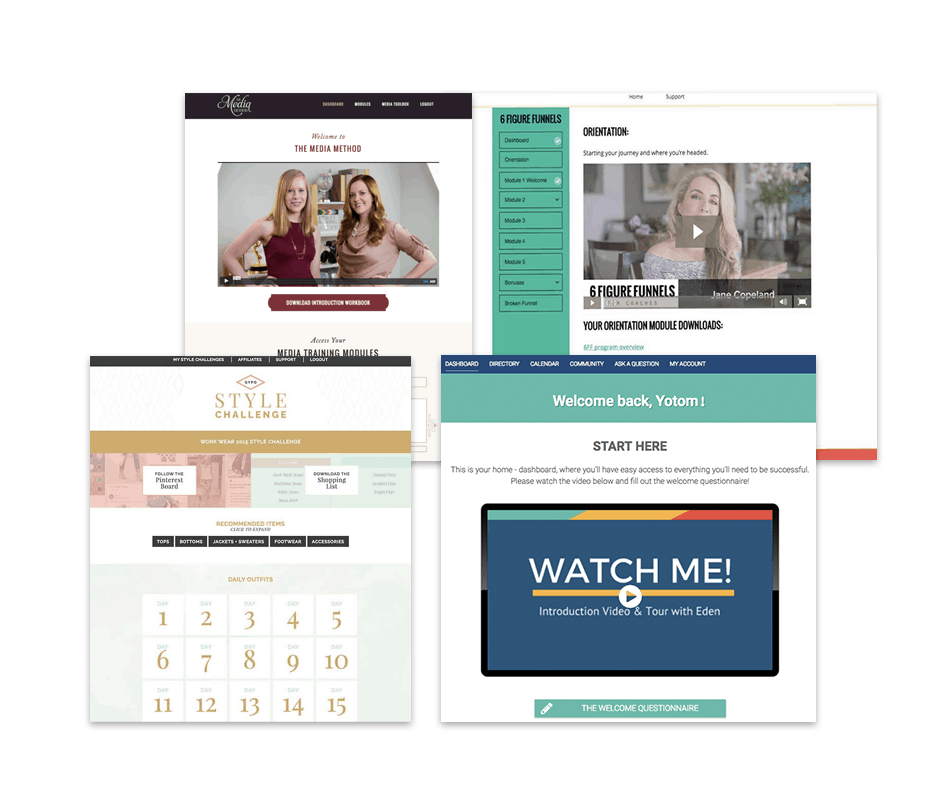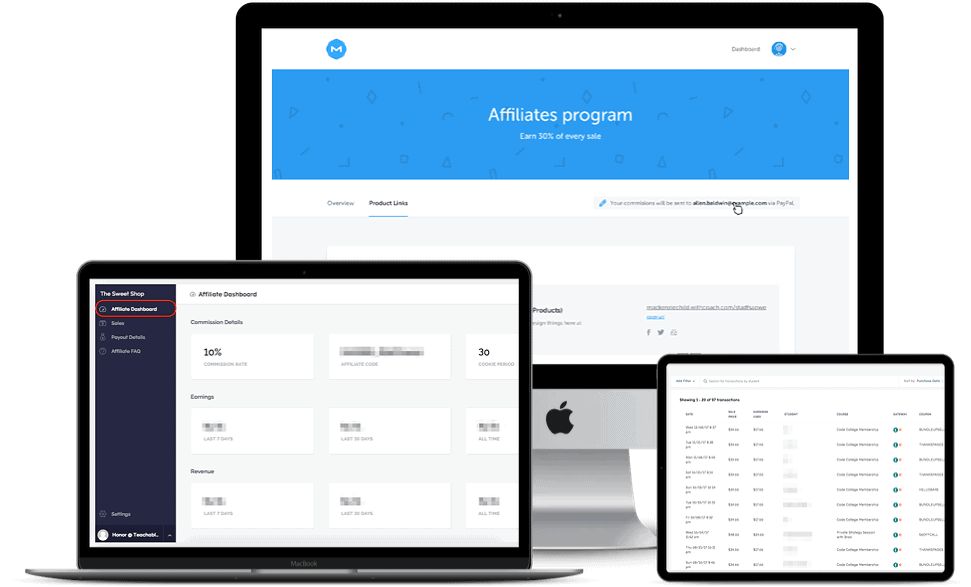Teachable vs. Podia: a comparison
In this Teachable vs. Podia comparison, we review two course platform options so you can see the key differences between functionality, design flexibility, integration options, ease of use, pricing models, and ongoing customer support.
Reviewing course platforms can quickly become overwhelming, which makes it difficult to choose the best software for you and your business. This article will help you cut through the noise and focus on what really matters.
Why we're creating this online course platform comparison
We’ve tested so many course software solutions for our business over the years.
When we couldn’t find a solution that would do what we needed, we dusted off our Software Engineering chops and developed AccessAlly.
And to this day, we continue to test and review the options on the market so we can share that knowledge.
Today we’ll share what we know about Podia and Teachable.
How do Teachable and Podia Differ?
Teachable and Podia are both platform-as-a-service options. This means that you can upload your content, manage your members, and get your site up and running without building a lot of infrastructure.
That’s where the similarities end and the differences begin.
Though they share the platform-as-a-service distinction, they have different philosophies and are designed to support your business in different ways.
All-in-one vs. course builder
Podia is an all-in-one, platform-as-a-service provider that tries to do everything from hosting your website and handling email marketing to designing landing pages, taking payments, delivering online courses, and managing memberships.
Podia offers a “plug-and-play” setup so you can set up your storefront, add website pages and products, and start taking payments without being a tech expert.
It is a plus to be able to get your website up and running quickly, however, since this is a platform-as-a-service provider, you’re building on “rented” land. Meaning you don’t actually own your website and when it comes time to move to a different system, you’ll have a manual migration on your hands. You might also discover you have limits in place on what you can and can’t do with your website.
Teachable is focused on online course creation and education. They too have an easy setup process so you can get your site up and running quickly.
Within their framework, you can build an online course and deliver a powerful learning experience without extensive setup and technical knowledge.
You can start with your own free subdomain through Teachable (yourschool.teachable.com), you can host under your own domain name (yourschool.com), or you can link to a subdomain (member.yourschool.com).
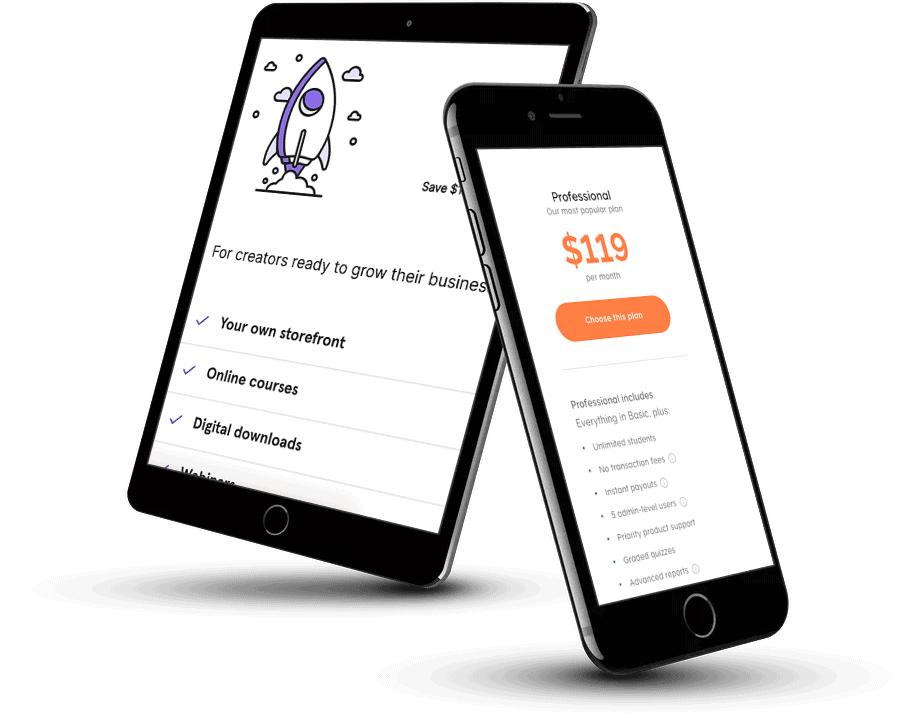
Pricing: monthly Costs, Tiers, and Feature Limitations
Pricing is an important factor in the decision-making process when it comes to choosing the platform or software that will power your membership or online courses.
Understanding the full picture is going to be key for your business.
Not only should the cost of the platform itself be considered, but any add-ons, integrations, upgrades, or other required (or desired) systems, should also be factored in to ensure any investment surprises won’t pop up along the way.
Teachable is unique in that they offer a free monthly plan. There is a 10 student limit on this plan, so this would be a good option to get up and running or use as a foundation to build out your course without having to pay a start up cost until you’re ready to start selling, but know that you’ll have to upgrade to a paid plan very soon.
Teachable has three paid tiers:
-
- Basic ($39)
- Professional ($119)
- Business ($299)
All paid plans have unlimited courses and students. There are transaction fee differences depending on your tier. For example, the Basic plan has a 5% transaction fee, but the Professional and Business plans are 0%.
The different tiers offered by Teachable do however, have limitations on features. To truly achieve a high-end learning experience, using a lot of the features we compare in this article, the Professional plan ($119/ month) is required.
The Basic plan ($39 / month), leaves out essential features like graded quizzes, an integrated affiliate program, certificates of completion, course compliance, reporting, and design flexibility. It’s also important to note that there’s no live chat support on the Basic plan.
In comparison, Podia offers two tier options to meet your needs:
-
- The Mover ($39)
- Shaker ($79)
These plans are distinguished mostly by feature limits.
The Mover plan leaves out memberships, blog functionality, offsite buy buttons, affiliate marketing, and the ability to incorporate third party code. If these elements are part of your business now, or will be in the future, budget for the Shaker plan.
In summary, unless you’re just getting started or run a bare-bones course or membership, you’re mostly likely going to need the Professional ($119) plan with Teachable and the Shaker ($79) plan with Podia.
Ongoing Development and Ownership
As with any platform-as-a-service, there is a lack of full ownership of your content and setup because you’re essentially building your business on rented land. Meaning that Podia and Teachable own the space you’re set up on.
When you outgrow these platforms or want to uplevel your business, you’ll have to manually migrate off these platforms.
Teachable posts monthly updates on their blog for feature updates and changes. They also post any fixes implemented that month as well as what’s coming up next. They do a great job of telling their customers what to expect in terms of upcoming feature updates.
Podia does not offer any similar monthly posts with updates and what to expect. The best way to find out about upcoming feature changes and development is to email into their support team.
Looking for an Option with less restrictions?
Have full control of your content, members, and their experience on your site.
Spend your time doing what you do best, not struggling with frustrating platform restrictions.
With AccessAlly, you’ve got all of the power and flexibility of WordPress, and there are no limits on your business’ growth potential either.
What AccessAlly Customers Are Saying...
"When Comparing Course Platforms, Look At Both The Leadership And The Software
You guys might be one of the smartest and hardest working platforms out there.
AccessAlly is so so so good. It’s literally at the core of my business!
It really is a pleasure being a customer of AccessAlly.”- Michael Killen,
sellyourservice.co.uk

"Fewer integrations are needed to make it all work
- The look of the membership site
- Ease of adding audio/video
- Branding options on the site
- Your own website versus someone else’s hosted platform
AccessAlly is an amazing tool!”
– Robin Hardy, integrityvirtualservices.com
Customer Support
Implementing your newly purchased software or platform takes a lot of bandwidth, implementation, learning a new system, and almost always customer support. This is just part of the process.
Having access to great customer support, or not so great support, during your new setup can make or break your launch. Setting up the user experience and learning environment that your students expect and deserve will result in better retention rates with the material and long-term relationships with your students.
Teachable offers an extensive knowledge base with well-organized, detailed articles complete with step-by-step instructions and tutorials. Their support hours 8am-8pm ET, 7 days per week via email. On the upper tiers you can access chat support Monday-Friday 10am-5pm ET.
Podia does have chat support at any tier, and they clearly state their email business hours and response time. Podia has a team page so you can become familiar with the folks on the support team.
They too have help articles in their Help Center so that you can research and find answers on your own.
Integration with your Email marketing automation platform
Both Podia and Teachable can integrate with a variety of marketing automation tools using a third-party connection like Zapier.
If you already have a CRM that you use, these platform-as-a-service options will integrate with your setup using Zapier.
Each of these platforms has some built-in marketing automation options. Teachable for example has a basic built-in email automation feature. This allows you to send emails to students based on their actions on the site. This is referred to as a one-way integration. Teachable can communicate with your CRM through a third-party like Zapier. Your CRM software won’t communicate with Teachable to trigger actions, unlocking content, or prompts to complete certain modules.
Podia offers a simple way to communicate with your customers via newsletters, drip campaigns, and automated emails with segmentation. Their functionality isn’t as advanced or flexible as what you’ll find in a marketing automation tool like ConvertKit, Keap, or Infusionsoft, among many others.
Neither of these options offer a deep two-way integration with an email automation tool and the membership site, meaning actions in one won’t automatically sync with the other.
Looking for something that integrates both ways?
Marketing automation tools are here to stay.
Use your marketing automation tool to power your course and membership program by taking advantage of AccessAlly’s deep 2-way street integration.
It’s built to help you sell more, teach better, and engage with your students longer.
Learning reinforcements: quizzes, Certificates, and Compliance
Offering learning reinforcements throughout your courses and membership provides your students with more accountability, checkpoints throughout their course or membership, and creates a learning environment that makes a significant impact.
On the Professional tier, Teachable offers great options for these learning reinforcements like quizzes, course completion certificates, course compliance markers, and required passing scores. Teachable outshines Podia in this department.
Podia offers quizzes to enhance learning, but they do not offer course compliance features such as Teachable, customized certificates of completion, or required passing scores.
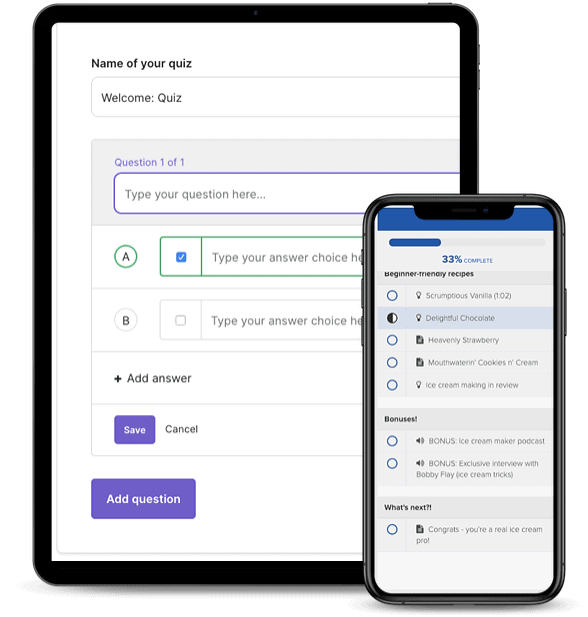
design flexibility
Part of the appeal of using something like Podia or Teachable is that it works out-of-the-box with little design and building necessary.
These platform-as-a-service options will let you customize their done-for-you design templates. The basic infrastructure is built, but going back to the home analogy: you’re coming in to decorate your rented home. You won’t be able to do a full remodel, but you can change the paint (colors) and make a few other changes.
On the more advanced or higher-priced tiers, third party code and more in-depth customization is possible, on both platforms.
Podia makes it possible to build your website and courses with a flexible layout, live previews, and the ability to customize your logo and colors. If custom design is high on your priority list, and you know that you will need more advanced customization with the ability to add third party coding, remember to budget time and money for design, implementation, updates, and maintenance as necessary.
Teachable offers a drag-and-drop builder to help build your website or create new pages. They offer a Power Editor that allows the code to be modified for further customization.
The Teachable branding will be included with the out-of-the-box designs on the lower tiers. If you want to remove their branding from your courses and pages, be sure you’ve selected the appropriate tier to do so.
If you want full design flexibility, AccessAlly is for you
Because AccessAlly is a WordPress plugin, you can use any WordPress theme or builder you like.
Or start with AccessAlly’s theme, which comes with all of the progress tracking and navigation menus integrated out of the box.
Power, flexibility, and beauty all in one course platform.
bulk course enrollment
Bulk course enrollment allows you to create a set of online courses that can be sold to multiple people at one time.
This feature serves business models who sell their courses or memberships to companies, families, or schools. The team leader can assign the allotted number of courses purchased to each student on their team.
This becomes a powerful selling tool that can change the way you sell your training and expand your business in a whole new way.
Neither Podia or Teachable offers a fully automated solution for bulk course enrollment. However, with Podia it is possible to sell online courses by creating an offer for the specific number of people to enroll, and using coupon codes to enroll them.
This setup on Teachable would work for on-off situations or on an as needed basis, but it would be challenging to expand and grow that feature of your business.
E-commerce and affiliate functionality
Both Podia and Teachable integrate with Stripe and PayPal. On Podia, membership payments can only be paid via Stripe, not through PayPal because their system does not support recurring PayPal payments or recurring subscriptions.
Teachable Payments are available for customers operating in the United States, Canada, or the UK. Teachable Payments uses Stripe Express to accept credit cards as well as PayPal.
Teachable pays out your earnings on a monthly basis set a payout schedule that you can set on your Teachable Payments dashboard. Stripe payouts can occur daily, weekly, or monthly. There is a 30-day delay on PayPal payouts. Note again, that depending on your tier, there are transaction fees associated with each sale.
Podia accepts international payments based on Stripe’s policies. Payouts happen instantly with no delays, and there are no additional transaction fees. This is a +1 in the win column for Podia users.
Consider that no matter which software or platform you choose, you may find yourself needing a way to calculate tax worldwide. AccessAlly offers a Quaderno integration that does just that and integrates seamlessly with your AccessAlly order forms.
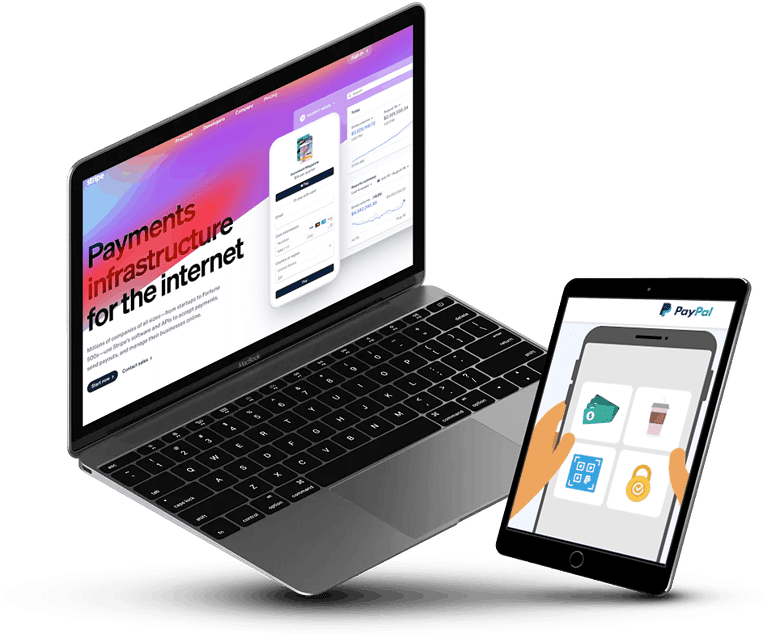
Podia and Teachable both provide affiliate marketing capabilities on specific tiers.
Podia offers a program where customers can sign up to become affiliates, view their dashboard, find their unique links, and view commissions. There is no easy way within the affiliate dashboard to seamlessly share affiliate assets such as swipe copy, approved images, or other affiliate materials.
If you run a large, or multi-tiered affiliate program and want to easily share all resources with your affiliates in one central location, you’ll need to purchase another program or hire someone to share these assets, grow your affiliate program, and manage it fully.
Teachable and Podia are very similar in this regard. Teachable’s affiliate infrastructure makes it possible for affiliates to retrieve their links, view commissions, and payout details from their unique login.
There’s not a seamless way to share affiliate assets such as copy and images, so be sure to formulate a plan that will support sharing these with your affiliates.
If you run a robust affiliate program, or you’re planning to expand your affiliate program, you’ll very quickly outgrow these platforms. Choose a fully-functional, completely integrated affiliate system like AccessAlly. Register affiliates, share links, sales, commissions, and assets all from one beautifully designed, easy to use dashboard.
your workflow on Teachable vs. Podia:
- Setup your storefront and/or website pages
- Use Teachable’s domain or connect your own
- Customize the look and feel of your pages
- Upload your content and customize the look and feel of your course pages
- Connect any additional integrations needed with your email automation tools or setup emails in Teachable
- Enable your payments and setup terms of purchase
- Add any additional learning enhancements such as quizzes or certificates.
- Stay up to date on platform feature changes and make changes accordingly
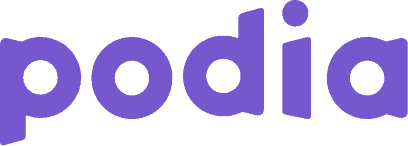
- Setup your storefront
- Add any connecting applications you might want to use, such as Zapier for integrations
- Choose your URL
- Migrate existing content or add new content to your website pages
- Add integrations such as Google Analytics or Facebook tracking pixel
- Customize the look and feel of your site by using the out-of-the-box editor or building something from scratch
- Build your online courses, digital downloads, memberships, and free or paid webinars.
- Setup your payments and terms of purchase
- Add your emails and marketing automations or integrate with a CRM
See How Teachable and Podia Features Compare
We’re a digital marketing software company built by marketers and software engineers. With our particular background and expertise, we’ve designed our membership and LMS plugin AccessAlly, to give you everything you need in an easy to use, powerful package. Here you’ll see where Teachable and Podia fall short or shine in comparison:
| Software Feature | AccessAlly | Teachable | Podia |
|---|---|---|---|
| Protected course content | |||
| Built-in Recurring Stripe and PayPal payments | No recurring with PayPal | ||
| Course builder for modules, lessons, and topics | |||
| Automatically creates tags, pages, and menus | |||
| Deep 2-Way Integration with Infusionsoft, Ontraport, ActiveCampaign, ConvertKit, and Drip | |||
| Multiple currencies, automated expiring coupons, and order bumps | |||
| Cart abandonment automation | |||
| Progress tracking, and progress-based unlocking content | |||
| Multiple types of quizzes, and auto generated certificates of completion | |||
| Course Licensing with Teams or Umbrella Accounts | |||
| Searchable member directories and editable custom fields through profiles | |||
| Gamification where members can earn points, and activity-based automation, login tracking | |||
| Media player, video bookmarks, tagging automation on quizzes | |||
| Cross-selling dashboards, with 1-click upsells | |||
| Built-in affiliate tracking with multiple tiers, links, and reporting | Limited | Limited |
The true cost of Teachable vs Podia
These pricing models will give you a realistic expectation of costs associated with Podia and Teachable.
If you plan to use the built-in email marketing automation in Podia, this may be a good fit for you. However, be prepared to flex your business model and get creative when you run into system limitations, or face a migration.
If you plan to use a third-party integration tool to connect Podia or Teachable to your existing CRM or marketing automation systems, be sure to budget time and money for those connections and maintenance.
If you already have a website and you’re only looking to build out your course offerings then Teachable may be a good fit for you.
In order to truly assess the cost of both of these platforms-as-a-service options, consider the long-term vision for your business and your membership site. Consider the cost of migrating off these platforms onto a software-as-a-service platform like AccessAlly.
We recommend selecting the best option that will not only fit your business right now but will scale with you as you grow instead of holding you back.
In Summary
Podia might be right for you if...
-
- You’re a creator looking for a simple course website
- You have offerings like free and paid webinar, digital downloads, or simple courses with no plans to expand to a fully functional and integrated membership site
- You’re willing to modify your setup when you’re met with Podia’s platform limitations
- You don’t have a CRM and plan to keep automation and interaction with your customers simple
- You won’t mind migrating off Podia and into a new software-as-a-service offering as your business grows
Teachable might be right for you if...
-
- You want to build a storefront or simple website quickly and get your courses for sale right away
- You’re willing to adapt your branding to fit within the ‘out-of-the-box’ design offerings
- You’re willing to increase your tier level to meet the needs of your business as you expand
- You won’t mind setting up your business on ‘rented land’ and manually migrating when your business grows
Researching course platforms on your own is great, but if you want to talk to someone, we're here to help!
If you’re wondering whether you’re on the right track or not, we can help you sort out all of the different options. We’ll let you know if AccessAlly is a good fit or not, too.
We’ll start by asking you a few questions and guide you in the right direction.
